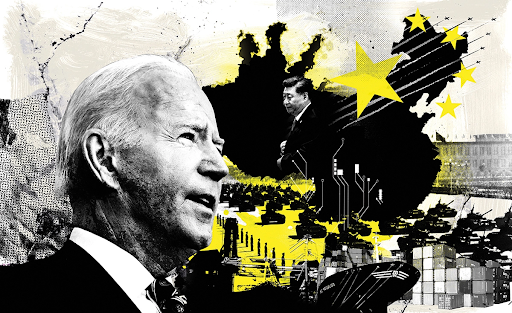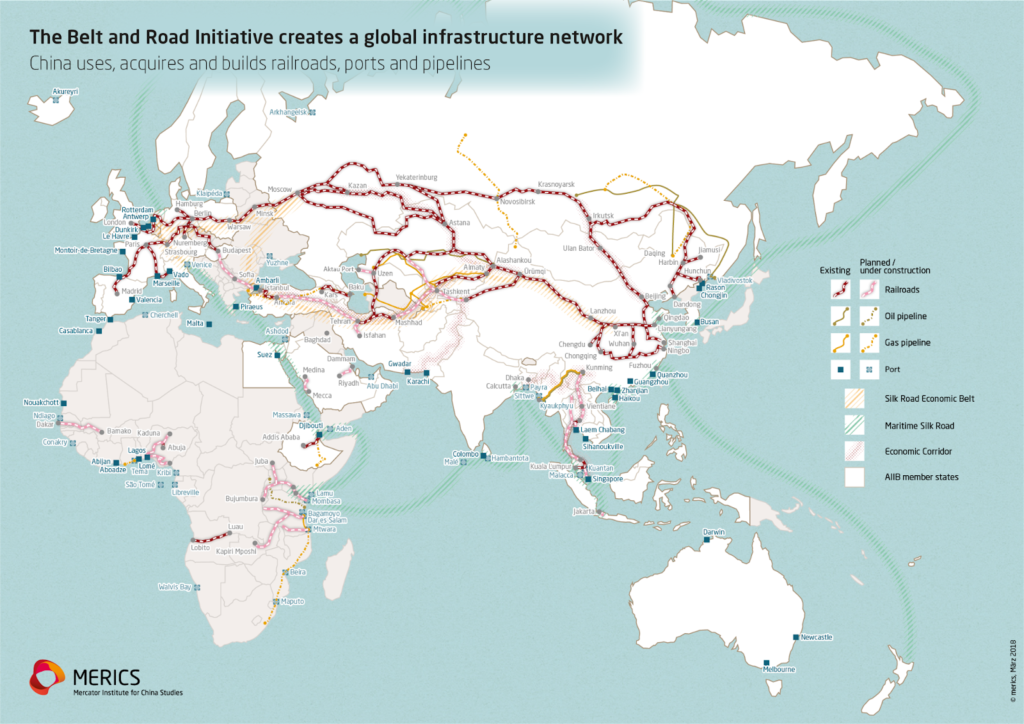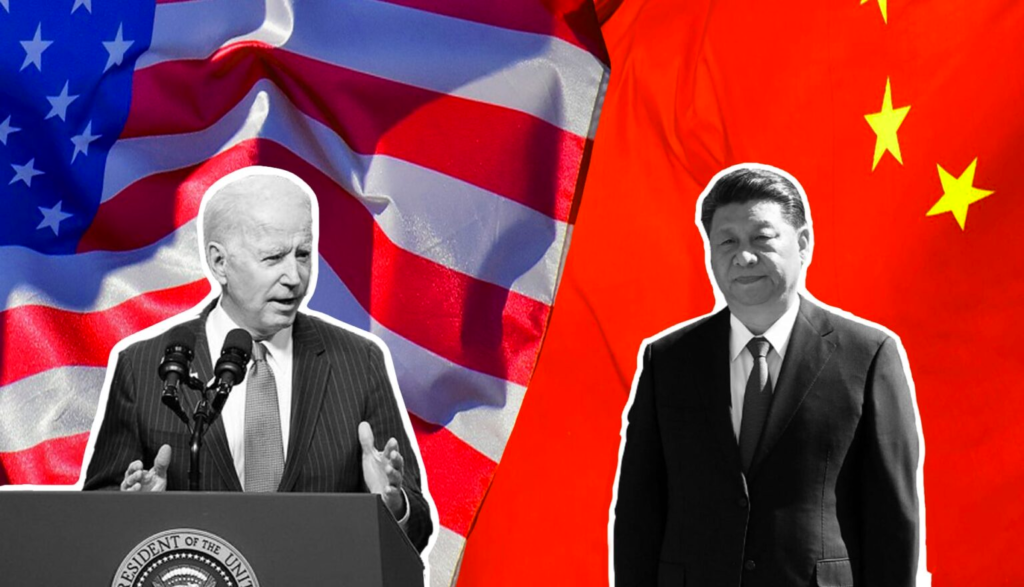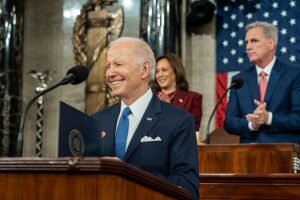China Briefs: The Perils of the US-China National Security Agendas
Is China a strategic competitor or adversary to the United States? To assess this question we must examine intent and capability — as a measure of power — within US and China regional goals in the Indo-Asia-Pacific.

Image Credit: Eleanor Shakespeare Illustrations for Foreign Policy
Is China a strategic competitor or adversary to the United States? To assess this question we must examine intent and capability — as a measure of power — within US and China regional goals in the Indo-Asia-Pacific. China intends to compete with the US on all levels of military and economic power. According to the 2022 US National Defense Strategy, China is the only state with the military, diplomatic, and economic capability to oppose and hurt US national goals in the Indo-Asia Pacific.
Competition and insecurity derive from the Chinese Communist Party’s (CCP) national security posture and economic goals. Their agenda does not align with the current rules-based international system. This is exemplified in China’s Belt and Road Initiative (BRI) to expand economic, financial, and geopolitical influence counter to the current liberal order. The BRI is a network of global infrastructure projects China has undertaken in mostly African countries. The profits gained from the projects increase China’s economic position and ability to assert power in that region. It also indebts receiving countries with higher interest rates and strict terms. In the end, the BRI creates an economic and financial dependency between the developing countries and China.

China’s “Defensive National Defense Policy” shows the government is threatened by the US presence in the Asia-Pacific region. While the CCP’s intention is to protect regional sovereignty, Washington’s agenda is to protect its position, influence, and allies in the region. These factors lead Washington to believe China is determined to transform the international system to be favorable to its own political system and national interests.
The international debate on COVID policy implementation and vaccine leadership forced both countries into an ideological competition between democracies and authoritarian states. The pandemic response was not only a competition for science and technology in global leadership, but it was also a test between which social and state structures could respond more effectively to a crisis. The pandemic exposed political dysfunction, ethnic and racial division, and economic stagnation in the US and other Western democracies, which discredited US leadership in the global system.
While the credibility of Western-democratic states has been in decline, the international system has fundamentally changed. In the 2021 Interim National Security Strategic Guidance, the White House stated that US adversaries — Russia and China — are becoming more assertive in the international system. Both nations struck up an alliance that is positioned to challenge US military and economic supremacy.
In the “Joint Statement of the Russian Federation and the People’s Republic of China on the International Relations” released on Feb. 04, 2022, both governments agreed to unlimited cooperation and shared views on democracy in their states:
The sides believe that democracy is a means of citizens’ participation in the government of their country with the view to improving the well-being of the population and implementing the principle of popular government… There is no one-size-fits-all template to guide countries in establishing democracy. A nation can choose such forms and methods of implementing democracy that would best suit its particular state…
The public alliance shows that both governments do not intend to follow US leadership. Instead, they will continue to pursue a version of democracy that is aligned with their national interests. Even more concerning than ideological alignment is the establishment of a public alliance with the intent to undermine US precedence in the liberal international system.
While China is opposed to the US liberal order, it has largely benefited from globalization and the liberal markets the US established after WWII. China’s rapid economic growth allowed it to become a major power. From 1978 to the present, China’s GDP growth has averaged over nine percent a year, and over 800 million people have been lifted out of poverty. These economic benefits came from Deng Xiaoping’s opening of the Chinese economy. From then on, China’s economy became embedded in global supply chains through globalization, and it joined the World Trade Organization in 2001 under President Hu Jintao. This allowed China greater access to the global market, improving its commercial and merchandise trade, manufacturing, Foreign Direct Investments (FDI), and agriculture each year from 2001 to 2011. Finally, in one of its most expansive global projects, China’s Belt and Road Initiative has allowed it to increase its geopolitical influence worldwide.
US-China competition is driven by ideological differences in democracy, societal order, and government structure. This notion fundamentally highlights why China does not see the international environment as favorable to its national interests. The US defines democracy through freedom, electoral politics, and individual expression, whereas China views freedoms in terms of social security and economic development. This difference in the methodology behind social security and state welfare drives the US-China competition and impacts the attractiveness of their global leadership to the international community.
Defense spending and military modernization indicate China’s intent to expand its capability to protect its regional interests against US encroachment. The Chinese military budget has doubled in the last decade and has increased each year. In March 2023 at the National People’s Congress, the CCP announced it will increase defense spending by 7.2% annually. This security strategy invests in nuclear, space, cyber, electronic warfare, and counter-space capabilities. It increases projected nuclear weapons procurement from 400 operational nuclear warheads to 1,500 nuclear warheads by 2035. In addition, Beijing unveiled new military readiness laws such as the implementation of air-raid shelters in cities across from Taiwan, passed a law that enables the People Liberation Army (PLA) to activate its reserves and institutionalized a system that allows replenishment of troops in the case of a war. The strategy adopts “multi-domain precision warfare,” a form of examining your adversaries’ operational vulnerabilities across multiple sectors. China’s defense strategies indicate that they view the US as not only a competitor but an adversary — with the potential for conflict.
China’s 2023 Defensive National Defense Policy states that the CCP views US intervention in territorial disputes as an infringement of its sovereignty. They would prefer to resolve territorial disputes directly with the states involved. These areas include the Taiwan Straits, Diaoyu Islands, and the South China Sea based on China’s historic claim to territories in the nine-dash line.
Ruled by the United Nations Convention on the Law of the Sea (UNCLOS) Arbitral Tribunal under the historic Arbitration Case Philippines v. China (2016), China’s historical claim does not follow regulations set by the UNCLOS. This decision was made to protect the coastal rights of the Philippines and set a precedent for countries in the future. In response, China used military strength to circumvent international law with hard power intimidation at these flashpoints. This is why China prefers to resolve territorial disputes directly. Without US intervention, China is free to assert its power in the Indo-Asia-Pacific. They can overpower and intimidate small states to secure their national interests.
China has long seen the world system as an extension of US power. The international system allows the US to interfere with China’s internal affairs as a regional security provider and economic powerhouse. From this perspective, the liberal order is a means to change the Chinese political system, and the US sphere of influence in Asia is part of Washington’s containment policy. On the other hand, to protect its allies in the region, the US maintains military forces and closely monitors the international waters surrounding its allies. These hostile areas, divided between democratic states and authoritarian states, increase US-China military competition — leaving both caught in a security dilemma.
The international liberal financial system values the dollar and free trade and is therefore also viewed as an extension of US influence. To challenge US supremacy, China has slowly built its own financial system — from the Asia Development Bank, Shanghai Cooperation Organization (SCO), and Asia Infrastructure Investment Bank to the BRI — that is meant to counter the liberal one and is more favorable to its terms and international goals. The Russia-Ukraine War caused a new era of deglobalization by emphasizing supply chain vulnerabilities and resource dependence. For China, this era of deglobalization and inflation is an opportunity to push back against the dollar’s supremacy.
Global inflation highlighted the disadvantages of tying currency to the US dollar; periods of low dollar valuation hurt foreign countries during international transfers and arbitration. These developments allowed China to lobby trade partners, including major B.R.I.C.S. countries (Brazil, Russia, India, China, and South Africa), to drop the dollar. This new development not only devalues the currency but also undermines US supremacy in the financial market. The financial wars signal a major shift in Chinese and global attitudes toward the US-led liberal order. China is actively trying to undermine US supremacy in the international market to create its own rules of the game.
China’s economic, military, and political strength allows it to gain allies and cement its global leadership under this new system. This multipolar system is more dangerous than the unipolar post-Cold War system that existed before. Multipolarity introduces new actors and disrupts the previous balance of power. From China’s perspective — as well as other dissatisfied states — the post-Cold-War system perpetuated disadvantages in economic and military strength that they’ve sought to change.
This global system leaves weaker states to pick which ideology and country they side with for their own security and economic prosperity. Since its rise to power, China has maintained a unique identity as both a rising power and a developing country. This label signals its geopolitical alignment with the developing world and allows them to choose the “China Option” in development projects, ideology, and trade. This identity attracts great powers (Russia), middle powers (France), and small powers (African countries) who are drawn to China for their economic and political benefits.
From Washington’s perspective, China is a major competitor in the international system and an adversary in national security. According to the 2018 US National Defense Strategy, China poses a threat to US security, prosperity, and interests in the Asia-Pacific region. In March 2023 at the National People’s Congress, President Xi Jinping announced that China should be prepared for war, or “dare to fight.” China’s military modernization and expansion point to a long-term strategy that aims to displace US presence and influence in the region. In response, the US is working to maintain its military and economic position and influence to prevent China from reshaping the international order.
As China continues to rise in power and attract its own allies in the region through its form of global leadership, it will perceive the US encroachment and intervention as part of its containment policy. China’s ascendance threatens not only the US presence in the Indo-Asia Pacific and its ability to protect its allies in the region but also US global leadership. Beijing’s willingness and capability to create a new global system counter to the current liberal system – driven by globalization, international order, and free trade – is a major destabilizing force for the US and its national interests. As a result, both countries are caught in a competition between ideological lines for economic and military power.
Betty Lincoln (she/her) holds the position of JPI Academic Journal Editor-in-Chief. Additionally, she is a second-year NYU MA International Relations candidate. Her research focuses on security and economics in the Asia-Pacific. She obtained a B.A. in International Relations with a minor in Asian Studies from the University of San Diego. Currently, she is pursuing a one-year Pathways internship in legal compliance and civil justice at the US Department of Labor. Betty enjoys diplomatic work involving governments and private corporations, and she aims to apply her experience in risk management and corporate government affairs. In her free time, you can find her walking her greyhound around NYC, playing tennis, or running along the Hudson.








